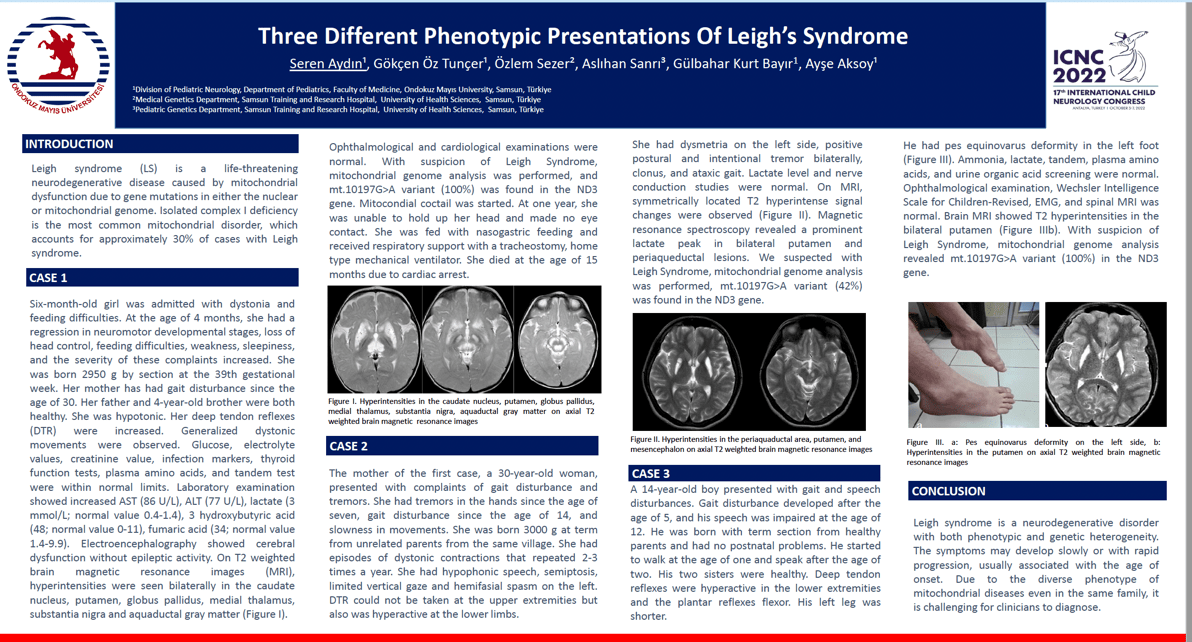Three Different Phenotypic Presentations of Leigh Syndrome
Seren AYDIN, Gökçen ÖZ TUNÇER, Özlem SEZER, Aslıhan SANRI, Gülbahar KURT BAYIR, Ayşe AKSOY
Three Different Phenotypic Presentations of Leigh Syndrome Introduction: Leigh syndrome is a life-threatening neurodegenerative disease caused by mitochondrial dysfunction due to gene mutations in either nuclear or mitochondria genome. Isolated complex I deficiency is the most common genetic defect in mitochondrial disorders and accounts for approximately 30% of cases as a common cause of Leigh syndrome. Case reports: We present three cases with 10197G>A mutation in the mitochondrial ND3 gene from 2 families. While a 6-month-old girl had complaints of progressive neuromotor retardation, dystonia, feeding, and breathing difficulties, her 30-year-old mother had tremor, ataxia, and dystonia. A 14-year-old boy from another family was admitted with left hemidystonia and speech disorder. Brain magnetic resonance imaging of patients showed T2 weighted-FLAIR hyperintensity in bilateral basal ganglion and mesencephalon. Conclusion: Leigh syndrome is a neurodegenerative disorder with both phenotypic and genetic heterogeneity. The symptoms may develop slowly or with rapid progression, usually associated with age of onset. Due to the diverse phenotype of mitochondrial diseases even in the same family, it is a challenge for clinicians to diagnose.
Keywords: Leigh syndrome; Complex I deficiency; Mitochondrial ND3 gene
Seren AYDIN
Ondokuz Mayıs University, Faculty of Medicine
Turkey
Gökçen ÖZ TUNÇER
Ondokuz Mayıs University, Faculty of Medicine
Turkey
Özlem SEZER
University of Health Sciences, Samsun Training and Research Hospital
Turkey
Aslıhan SANRI
University of Health Sciences, Samsun Training and Research Hospital
Turkey
Gülbahar KURT BAYIR
Ondokuz Mayıs University, Faculty of Medicine
Turkey
Ayşe AKSOY
Ondokuz Mayıs University, Faculty of Medicine
Turkey
Three Different Phenotypic Presentations of Leigh Syndrome Introduction: Leigh syndrome is a life-threatening neurodegenerative disease caused by mitochondrial dysfunction due to gene mutations in either nuclear or mitochondria genome. Isolated complex I deficiency is the most common genetic defect in mitochondrial disorders and accounts for approximately 30% of cases as a common cause of Leigh syndrome. Case reports: We present three cases with 10197G>A mutation in the mitochondrial ND3 gene from 2 families. While a 6-month-old girl had complaints of progressive neuromotor retardation, dystonia, feeding, and breathing difficulties, her 30-year-old mother had tremor, ataxia, and dystonia. A 14-year-old boy from another family was admitted with left hemidystonia and speech disorder. Brain magnetic resonance imaging of patients showed T2 weighted-FLAIR hyperintensity in bilateral basal ganglion and mesencephalon. Conclusion: Leigh syndrome is a neurodegenerative disorder with both phenotypic and genetic heterogeneity. The symptoms may develop slowly or with rapid progression, usually associated with age of onset. Due to the diverse phenotype of mitochondrial diseases even in the same family, it is a challenge for clinicians to diagnose.
Keywords: Leigh syndrome; Complex I deficiency; Mitochondrial ND3 gene
Seren AYDIN
Ondokuz Mayıs University, Faculty of Medicine
Turkey
Gökçen ÖZ TUNÇER
Ondokuz Mayıs University, Faculty of Medicine
Turkey
Özlem SEZER
University of Health Sciences, Samsun Training and Research Hospital
Turkey
Aslıhan SANRI
University of Health Sciences, Samsun Training and Research Hospital
Turkey
Gülbahar KURT BAYIR
Ondokuz Mayıs University, Faculty of Medicine
Turkey
Ayşe AKSOY
Ondokuz Mayıs University, Faculty of Medicine
Turkey

Seren AYDIN
Ondokuz Mayıs University,
Faculty of Medicine
Turkey
Ondokuz Mayıs University,
Faculty of Medicine
Turkey